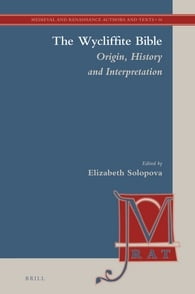Summer is a great time to catch up on new work related to Wycliffites and late-medieval religion. Important books from 2016 include a collection of essays that puts Wycliffism in a pan-European context and three new volumes on the Wycliffite Bible.
Europe After Wyclif
Ed. by J. Patrick Hornbeck, II and Michael Van Dussen

From Fordham University Press: “This volume brings together scholarship that discusses late-medieval religious controversy on a pan-European scale, with particular attention to developments in England, Bohemia, and at the general councils of the fifteenth century…Europe After Wyclif was designed specifically to encourage analysis of cultural cross-currents—the ways in which regional controversies, while still products of their own environments and of local significance, were inseparable from cultural developments that were experienced internationally.”
The Wycliffite Bible: Origin, History and Interpretation
Ed. by Elizabeth Solopova

From Brill: “The Wycliffite Bible: Origin, History and Interpretation brings together contributions by leading scholars on different aspects of the first complete translation of the Bible into English, produced at the end of the 14th century by the followers of the Oxford theologian John Wyclif. Though learned and accurate, the translation was condemned and banned within twenty-five years of its appearance. In spite of this it became the most widely disseminated medieval English work that profoundly influenced the development of vernacular theology, religious writing, contemporary and later literature, and the English language. Its comprehensive study is long overdue and the current collection offers new perspectives and research on this, the most learned and widely evidenced of the European translations of the Vulgate.”
Manuscripts of the Wycliffite Bible in the Bodleian and Oxford College Libraries
By Elizabeth Solopova

From Liverpool University Press: “The catalogue contains detailed descriptions of all (64 in total) manuscripts of the Wycliffite Bible in Oxford collections (the Bodleian and college libraries). This is a substantial part of the whole corpus: 250 manuscripts of the Bible survive and Oxford has the largest number of copies in any single location. The descriptions are subdivided into sections covering textual contents, decoration, dialect, physical makeup and binding of each manuscript, and are accompanied by bibliographies. The descriptions are preceded by an introduction with a discussion of the manuscript tradition of the Wycliffite Bible and the findings resulting from the study of Oxford copies. The catalogue also contains several appendices illustrating important features of the manuscripts.”
The Middle English Bible: A Reassessment
By Henry Ansgar Kelly

From the University of Pennsylvania Press: “Translated shortly before 1400, the Bible became the most popular medieval book in English. Prevailing scholarly opinion calls it the Wycliffite Bible, attributing it to followers of the heretic John Wyclif, and claims it was banned in 1407. Henry Ansgar Kelly disagrees, arguing it was a nonpartisan effort and never the object of any prohibition.”